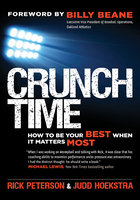
Reframing Cole’s Hockey Tryout
To continue with the hockey theme, I will share a personal story of managing my Caveman’s reflexive reaction and bringing my Conscious Thinker into the game. It’s September 1, 2015, the first night of hockey tryouts for my then 12-year-old son, Cole. He’s trying out for a club he’s not played with in the past. He’s skated with 25 kids all summer who are competing for 17 roster spots. At the conclusion of tryouts, there will be some heartbroken kids who get cut.
When we show up at the ice rink for the first night of tryouts, Cole is handed a white tryout jersey with a black number 28 on the back so he can be identified by the coaches who are evaluating the players.
My wife Sherry and I settle into our seats among other parents to watch the tryout. Based on what I’ve learned and shared with Cole about reframing pressure, I’m hopeful he will remain poised and will demonstrate his skills.
The kids are separated into two teams, one with black-colored jerseys and the other with white-colored jerseys. As the kids go through the typical pre-game warm-up routine that includes shooting on the goalies, my wife and I quickly notice many of the most skilled players are wearing black jerseys. It’s a good bet the kids on the black team have already secured roster spots. It’s not lost on either of us that Cole is on the white team.
When the scrimmage begins, the black team quickly asserts its dominance. The white team is overmatched. To say fear, worry, and doubt creep into our minds is an understatement.
Sherry voices her fears to me. “This is really bad. It’s so unfair. Why would the coach set up the teams to be so uneven? Maybe we shouldn’t even have him go to tomorrow night’s tryouts (when the team’s roster is chosen). I can’t stand seeing Cole get hurt. Let’s just go back to the team he played with last year.” Truth be told, the initial reaction from my Caveman is just as strong as Sherry’s reaction. The only difference between Sherry’s reaction and my reaction is I don’t say out loud what my Caveman is thinking.
Because I’ve been immersed for the past couple years in the topic of reframing pressure from threat to opportunity, I recognize this as the perfect time to use this skill. I start by pausing and recognizing what Sherry has voiced and what my Caveman is saying to me. Once I realize I don’t want to think or feel this way, I start asking questions to challenge my Caveman. Instead of assuming the worst—everyone wearing a white jersey will be cut from the team—I ask questions and look for different ways to interpret the facts of the situation.
I ask, “Why might the coach set up the teams this way?” “What is he trying to evaluate in such a lopsided scenario?” As a former coach who has been through the tryout process on multiple occasions, I think this coach might be trying to evaluate a small number of players on the white team in the toughest circumstances possible. If a player on the white team can perform well against a team full of highly skilled players, then he’s likely to perform even better if he plays on the same post-tryout team as these highly skilled players.
Then, being as objective as possible, I ask, “How is Cole performing?” As I watch Cole play, I notice him performing well and demonstrating his skills in a variety of difficult situations. He isn’t perfect, but that’s an unrealistic expectation for him. In the course of an hour of play, no 12-year-old hockey player is flawless.
I share my reframed thinking with Sherry and both of us are able to calm our minds. More importantly, as parents, this allows us to have a calm, rational conversation with Cole following the tryout. On the car ride home from the rink, I want to know how Cole is feeling about the first night of tryouts. I ask him, “How do you think you played tonight?”
Cole responds calmly, “I think I played pretty well. It was tough out there because the other team had most of the best guys, but I think that’s the way coach wanted it so he could see how the rest of us played against the toughest competition possible.” Either the coach let the kids know this or Cole did some reframing of his own to keep himself calm. I don’t let Cole know it took me longer than it took him to come to this same effective and objective interpretation of the situation. The next night, we receive the fun news that Cole made the team. Reframing pressure—even a 12-year-old hockey player can do it!
Fast-forward to March 13, 2016. Cole and his team finish a great season by winning the Illinois AA state championship. During the celebration, I pause to think about how Cole might have missed out on this memorable season if he hadn’t known how to reframe the threat he faced during tryouts.